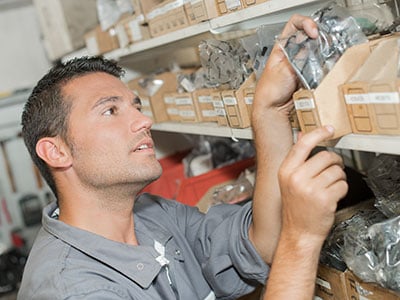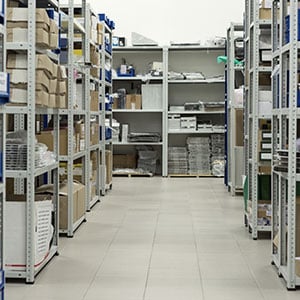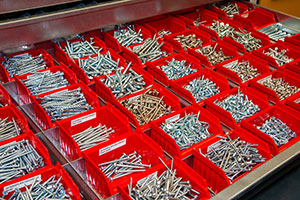How to Organize a Parts Room
 Many businesses rely on parts rooms to streamline their inventories and keep their stock organized. Unfortunately, these areas are prone to clutter and confusion. This, in turn, can make everyday operations a lot less efficient and may even lead to inventory loss and a greatly diminished bottom line.
Many businesses rely on parts rooms to streamline their inventories and keep their stock organized. Unfortunately, these areas are prone to clutter and confusion. This, in turn, can make everyday operations a lot less efficient and may even lead to inventory loss and a greatly diminished bottom line.
To limit the potential for these problems, we've detailed everything you need to know about organizing and managing your parts room. Keep reading to learn what goes into effective parts management at your warehouse.
Parts Inventory Organizational Tips
Parts organization can feel complicated due to the sheer number of parts present, not to mention their various manufacturers, shapes, and sizes. A strong inventory is desirable in that it enhances opportunities to produce greater customer satisfaction — but there are also downsides involved: it takes time and effort to keep these parts organized and, if they aren't kept in check, the risks of inefficient operations (not to mention, lost or stolen parts) increase considerably.
Struggling to make sense of so many parts? A solid system can limit confusion and keep your parts room running smoothly. Follow these steps to level up your inventory organization strategy for your parts department:
Train Staff for Maximum Efficiency and Safety
 No parts strategy will prove effective if employees struggle to understand or remember how these spaces are supposed to function. Avoid confusion by training warehouse staff on the organization system, labeling conventions, and the use of the inventory management systems in your facility. This ensures everyone follows the same process and knows exactly what to expect. Personnel who know how to properly operate and maintain these systems are also far less likely to suffer a workplace mishap if something goes wrong.
No parts strategy will prove effective if employees struggle to understand or remember how these spaces are supposed to function. Avoid confusion by training warehouse staff on the organization system, labeling conventions, and the use of the inventory management systems in your facility. This ensures everyone follows the same process and knows exactly what to expect. Personnel who know how to properly operate and maintain these systems are also far less likely to suffer a workplace mishap if something goes wrong.
Make Sure Everything Has a Place
 Not all items deserve to take up space within your storeroom. First things first: ditch the clutter and ensure that specific spaces are allocated for every item. This suggestion might seem simple, but it's frequently neglected.
Not all items deserve to take up space within your storeroom. First things first: ditch the clutter and ensure that specific spaces are allocated for every item. This suggestion might seem simple, but it's frequently neglected.
Clutter can include spare parts that are no longer needed onsite. This makes it important to have a system to determine when parts are no longer required to be on hand. This systematic solution should also address how such parts can be moved so they no longer occupy valuable space or clutter your parts area. Clutter that qualifies as trash should be promptly discarded.
Next, determine where specific storage shelves, pallets, and bins will go — and how this relates to specific types of parts. Bin locations should be clearly labeled, so employees always know exactly where to head and how to retrieve essential items. For other, loose essentials, provide a dedicated space — such as a high-density cabinet or storage solutions that will help you keep track of a variety of items.
Have an Organization System
 Now that clutter is a thing of the past, you need a plan for how you'll organize your parts department — and how you'll keep it organized for the long run. Often, the best solutions are the simplest: organize by the type of part, for example, or according to the manufacturer.
Now that clutter is a thing of the past, you need a plan for how you'll organize your parts department — and how you'll keep it organized for the long run. Often, the best solutions are the simplest: organize by the type of part, for example, or according to the manufacturer.
It’s important that your organizational system is accessible and efficient for your workers. Arrange frequently used parts in easily accessible areas and reserve prime spots for high-demand items to reduce the time spent searching.
Avoid the temptation to simply place the newest stock wherever there's room. This haphazard approach may save time in the short term but will lead to a lot of confusion down the road. No one organization system is right for every business, but simply having one in place will make a world of difference.
Put the Heavy Stuff Low To The Ground But Use Vertical Space
 Many of the greatest challenges surrounding parts management stem from the simple reality that parts come in many shapes and sizes. This can make organization tricky not only from the perspective of allocating specific spaces for specific items, but also because some items are more conducive to stacking than others.
Many of the greatest challenges surrounding parts management stem from the simple reality that parts come in many shapes and sizes. This can make organization tricky not only from the perspective of allocating specific spaces for specific items, but also because some items are more conducive to stacking than others.
Vertical space is always important, but there's a caveat: if this isn't structured properly, heavy items placed too high are at risk of falling. This results in damage to key parts, of course, but can also be a huge safety hazard. The solution? Always place heavier items low to the ground while using vertical space to allocate smaller parts.
When in doubt, look to sturdy and strategically selected shelving or racking systems to optimize vertical storage. The ideal shelving setup will largely depend on the types of parts required — not to mention, the size of the storage space and the number of items. Therein lies the value of customized solutions, which can be tailored as needed to fit the unique needs of each space.
Keep it Organized and Clean
 Depending on the function and scope of your parts department, you may need to adjust your storage space on occasion to reflect overarching changes at your facility or industry-wide fluctuations in demand. Seasonality may play heavily into this, so make a plan for how you'll stock in advance, especially when upticks are anticipated. Continue to assess your organizational system throughout these periods to determine where bottlenecks occur and whether any adjustments can be implemented to improve workflows throughout the year.
Depending on the function and scope of your parts department, you may need to adjust your storage space on occasion to reflect overarching changes at your facility or industry-wide fluctuations in demand. Seasonality may play heavily into this, so make a plan for how you'll stock in advance, especially when upticks are anticipated. Continue to assess your organizational system throughout these periods to determine where bottlenecks occur and whether any adjustments can be implemented to improve workflows throughout the year.
Regularly clean and maintain the storage area to prevent dust, debris, or pests from affecting the parts' quality. Develop a cleaning schedule to ensure that all aspects of the storage area are regularly addressed — after all, it doesn't take long for dust and debris to accumulate. Remember: a clean environment is important not only from a hygienic perspective but also because this makes it easier to locate and access essential items.
Track Your Inventory
 Re-ordering and restocking are as important as organizing onsite stock, but how can you do this properly if you don't know what's lacking or where stock overages exist? This is where inventory tracking comes into play. Done consistently, this can significantly boost your productivity and profitability.
Re-ordering and restocking are as important as organizing onsite stock, but how can you do this properly if you don't know what's lacking or where stock overages exist? This is where inventory tracking comes into play. Done consistently, this can significantly boost your productivity and profitability.
Inventory management software is a must, as it goes above and beyond manual tracking to provide accurate — and actionable — insights. This is how you determine which parts are actually being used and where losses are most likely. Barcodes, QR codes, or RFID tags are also highly useful, allowing for easier integration via scanning. When in doubt, opt for systems that facilitate real-time tracking so you can draw on the most relevant information.
Discover the Most Effective Parts Room Strategies
As you refine your strategy for tracking and organizing your parts, look to the experts at Warehouse1 for actionable insights and high-quality storage solutions. Reach out today to learn more about our products, services, and systems — and the role they can play in optimizing your parts department.




